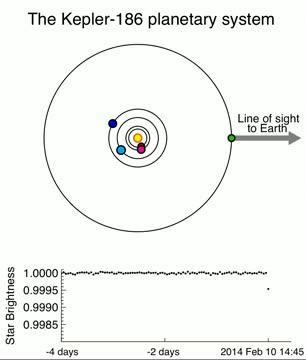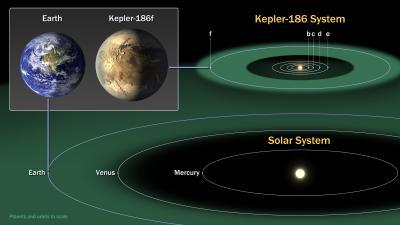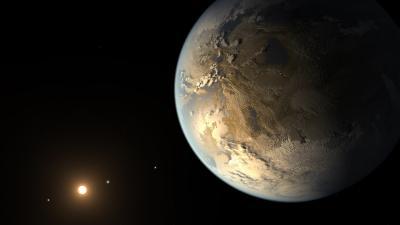"The Keck and Gemini data are two key pieces of this puzzle," says Quintana. "Without these complementary observations we wouldn't have been able to confirm this Earth-sized planet."
The Gemini "speckle" data directly imaged the system to within about 400 million miles (about 4 AU, approximately equal to the orbit of Jupiter in our solar system) of the host star and confirmed that there were no other stellar size objects orbiting within this radius from the star. Augmenting this, the Keck AO observations probed a larger region around the star but to fainter limits. According to Quintana,
"These Earth-sized planets are extremely hard to detect and confirm, and now that we've found one, we want to search for more. Gemini and Keck will no doubt play a large role in these endeavors."
The host star, Kepler-186, is an M1-type dwarf star relatively close to our solar system, at about 500 light years and is in the constellation of Cygnus. The star is very dim, being over half a million times fainter than the faintest stars we can see with the naked eye. Five small planets have been found orbiting this star, four of which are in very short-period orbits and are very hot. The planet designated Kepler-186f, however, is earth-sized and orbits within the star's habitable zone. The Kepler evidence for this planetary system comes from the detection of planetary transits. These transits can be thought of as tiny eclipses of the host star by a planet (or planets) as seen from the Earth. When such planets block part of the star's light, its total brightness diminishes. Kepler detects that as a variation in the star's total light output and evidence for planets. So far more than 3,800 possible planets have been detected by this technique with Kepler.

This animation depicts Kepler-186f, the first validated Earth-size planet orbiting a distant star in the habitable zone -- a range of distances from a star where liquid water might pool on the surface of an orbiting planet. The discovery of Kepler-186f confirms that Earth-size planets exist in the habitable zone of other stars and signals a significant step closer to finding a world similar to Earth. Kepler-186f is less than ten percent larger than Earth in size, but its mass and composition are not known.
(Photo Credit: : Sean Raymond.)
The Gemini data utilized the Differential Speckle Survey Instrument (DSSI) on the Gemini North telescope. DSSI is a visiting instrument developed by a team led by Howell who adds, "DSSI on Gemini Rocks! With this combination, we can probe down into this star system to a distance of about 4 times that between the Earth and the Sun. It's simply remarkable that we can look inside other solar systems." DSSI works on a principle that utilizes multiple short exposures of an object to capture and remove the noise introduced by atmospheric turbulence producing images with extreme detail.
Observations with the W.M. Keck Observatory used the Natural Guide Star Adaptive Optics system with the NIRC2 camera on the Keck II telescope. NIRC2 (the Near-Infrared Camera, second generation) works in combination with the Keck II adaptive optics system to obtain very sharp images at near-infrared wavelengths, achieving spatial resolutions comparable to or better than those achieved by the Hubble Space
Telescope at optical wavelengths. NIRC2 is probably best known for helping to provide definitive proof of a central massive black hole at the center of our galaxy. Astronomers also use NIRC2 to map surface features of solar system bodies, detect planets orbiting other stars, and study detailed morphology of distant galaxies.
"The observations from Keck and Gemini, combined with other data and numerical calculations, allowed us to be 99.98% confident that Kepler-186f is real," says Thomas Barclay, a Kepler scientist and also a co-author on the paper. "Kepler started this story, and Gemini and Keck helped close it," adds Barclay.

The diagram compares the planets of the inner solar system to Kepler-186, a five-planet system about 500 light-years from Earth in the constellation Cygnus. The five planets of Kepler-186 orbit a star classified as a M1 dwarf, measuring half the size and mass of the sun. The Kepler-186 system is home to Kepler-186f, the first validated Earth-size planet orbiting a distant star in the habitable zone—a range of distances from a star where liquid water might pool on the surface of an orbiting planet. The discovery of Kepler-186f confirms that Earth-size planets exist in the habitable zone of other stars and signals a significant step closer to finding a world similar to Earth. Kepler-186f is less than ten percent larger than Earth in size, but its mass and composition are not known. Kepler-186f orbits its star once every 130-days and receives one-third the heat energy that Earth does from the sun, placing it near the outer edge of the habitable zone. The inner four companion planets all measure less than fifty percent the size of Earth. Kepler-186b, Kepler-186c, Kepler-186d, and Kepler-186e, orbit every three, seven, 13, and 22 days, respectively, making them very hot and inhospitable for life as we know it. The Kepler space telescope, which simultaneously and continuously measured the brightness of more than 150,000 stars, is NASA's first mission capable of detecting Earth-size planets around stars like our sun. Kepler does not directly image the planets it detects. The space telescope infers their existence by the amount of starlight blocked when the orbiting planet passes in front of a distant star from the vantage point of the observer. The artistic concept of Kepler-186f is the result of scientists and artists collaborating to help imagine the appearance of these distant
(Photo Credit: : NASA Ames/SETI Institute/JPL-CalTech.)

The artistic concept of Kepler-186f is the result of scientists and artists collaborating to help imagine the appearance of these distant worlds.
(Photo Credit: : NASA Ames/SETI Institute/JPL-CalTech.)
Source: Gemini Observatory